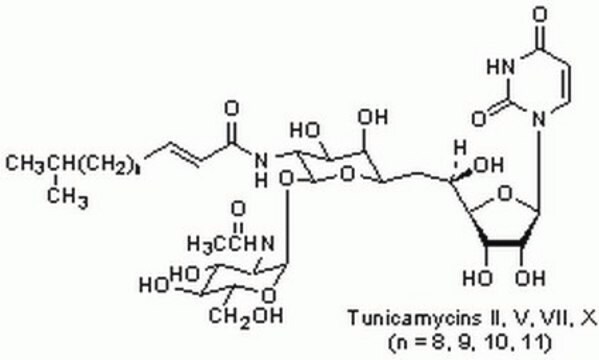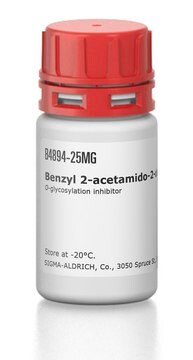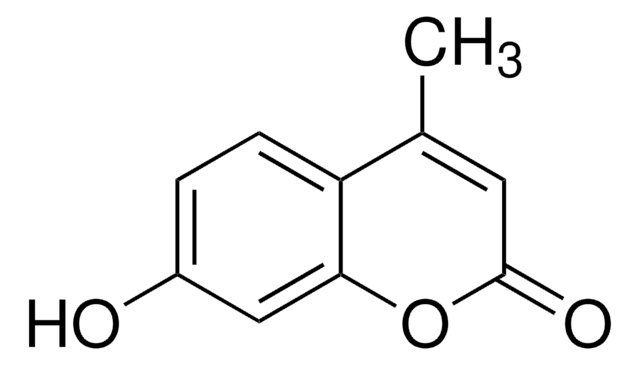T7765
Tunicamycin
from Streptomyces sp., ≥98% (HPLC), powder, N-acetylglucosamine transferase inhibitor
About This Item
Productos recomendados
Nombre del producto
Tunicamycin from Streptomyces sp.,
Nivel de calidad
solubilidad
95% ethanol: soluble 1 mg/mL, clear to faintly hazy
THF: soluble <1 mg/mL
dioxane: soluble <1 mg/mL
DMF: soluble >10 mg/mL
pyridine: >10 mg/mL
DMSO: soluble 4.9-5.1 mg/mL, clear to slightly hazy, colorless to yellow
methanol: slightly soluble 4.9-5.1 mg/mL
methanol: soluble 4.9-5.1 mg/mL, clear to slightly hazy, colorless to yellow
acetone: insoluble
aqueous base: insoluble
chloroform: insoluble
ethyl acetate: insoluble
espectro de actividad antibiótica
fungi
viruses
Modo de acción
protein synthesis | interferes
temp. de almacenamiento
2-8°C
cadena SMILES
CC(C)CCCCCCCC\C=C\C(=O)N[C@@H]1[C@@H](O)[C@@H](O)[C@@H](C[C@@H](O)[C@H]2O[C@H]([C@H](O)[C@@H]2O)N3C=CC(=O)NC3=O)O[C@H]1O[C@@H]4O[C@@H](CO)[C@H](O)[C@@H](O)[C@@H]4NC(C)=O
InChI
1S/C37H60N4O16/c1-18(2)12-10-8-6-4-5-7-9-11-13-23(45)39-26-30(50)27(47)21(54-36(26)57-35-25(38-19(3)43)29(49)28(48)22(17-42)55-35)16-20(44)33-31(51)32(52)34(56-33)41-15-14-24(46)40-37(41)53/h11,13-15,18,20-22,25-36,42,44,47-52H,4-10,12,16-17H2,1-3H3,(H,38,43)(H,39,45)(H,40,46,53)/b13-11+/t20-,21-,22+,25+,26-,27+,28+,29+,30-,31+,32-,33-,34-,35+,36+/m1/s1
Clave InChI
YJQCOFNZVFGCAF-WPTOCQRYSA-N
¿Está buscando productos similares? Visita Guía de comparación de productos
Descripción general
Aplicación
Acciones bioquímicas o fisiológicas
Nota de preparación
Palabra de señalización
Danger
Frases de peligro
Consejos de prudencia
Clasificaciones de peligro
Acute Tox. 1 Oral
Código de clase de almacenamiento
6.1A - Combustible acute toxic Cat. 1 and 2 / very toxic hazardous materials
Clase de riesgo para el agua (WGK)
WGK 3
Punto de inflamabilidad (°F)
Not applicable
Punto de inflamabilidad (°C)
Not applicable
Equipo de protección personal
Eyeshields, Faceshields, Gloves, type P3 (EN 143) respirator cartridges
Elija entre una de las versiones más recientes:
Certificados de análisis (COA)
¿No ve la versión correcta?
Si necesita una versión concreta, puede buscar un certificado específico por el número de lote.
¿Ya tiene este producto?
Encuentre la documentación para los productos que ha comprado recientemente en la Biblioteca de documentos.
Artículos
Inhibition of Cell Wall Biosynthesis by Antibiotics
Nuestro equipo de científicos tiene experiencia en todas las áreas de investigación: Ciencias de la vida, Ciencia de los materiales, Síntesis química, Cromatografía, Analítica y muchas otras.
Póngase en contacto con el Servicio técnico









